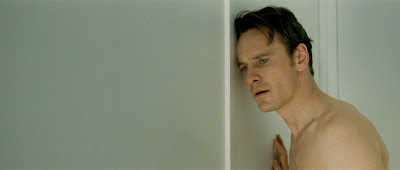 ★★★★
★★★★
Life imitates art. The
last film I saw by Suzuki, Take Aim at the Police Van, was in black-and-white
and ended in a train yard. Tokyo Drifter
starts in a train yard in black-and-white, focuses on a single red gun, and
then shifts into the full-blown color it’s famous for. It’s as though a director were managing my
film watching.
However, that director wouldn’t be Suzuki because such a transition
would be far too fluid. One of the style
flourishes that stands out here -- and
in Suzuki’s work in general, I think – is the jump cutting that makes a viewer
work to figure how to get from scene A to scene B. The first attack on Tetsu after he leaves Tokyo
is typical of the abrupt cutting. We see
a gang attacking the hideout, we see Tetsu fighting them, we see him walking in
snow whistling, we see the face-off with Viper on the track and then we’re back
in Tetsu’s hotel where he’s having his wound tended to. Figuring out how one of those scenes leads to
the other is quite a task. In other places, I nearly
missed who shot the girlfriend/secretary, I still don’t know what happened with
the attempted kidnapping, and I’m not sure why the car is destroyed in the
junkyard. Tokyo Drifter isn’t afraid to
rush forward while challenging you to keep up.
Changes in camera angles challenge, too, like the sudden cut to overhead
views when Tetsu is trapped in a pit and when the secretary is shot. Or the noir-ish low-angle
shot of the business meeting. In another
scene, we see Tetsu talking while leaning over a desk with some vague chair detail
in the background. After he talks
awhile, he stands up and turns around, continuing to talk. You do a double-take and see that he’s been
pensively leaning on the desk and that the person he’s been talking to all
along is, in fact, behind him. There is
a lot of such creative editing and camera work here, all the more surprising given how
pre-MTV this film is.
Character development in the film is analogous to story
development. We see Tetsu assume a
series of poses and attitudes, but we don’t see how he gets from one to the
other. Tetsu is in love, then he isn’t;
loyalty suddenly looms large in the plot.
Just like we get two different scenes and must figure out the connection, we
get a series of character attitudes and have to fill in the psychological blanks.
If, in fact, filling in the blanks is at all a concern
here. Tokyo Drifter could accurately be described
as a series of ecstatic scenes put together with some exposition. Suzuki gives us one strikingly-colored
composition after another. The hero
wears his robin’s egg blue suit and white shoes throughout, and we’re treated
to a series of brilliant sets in yellow, red and pink. The bar is yellow, the meeting room fuchsia, and
the office of building owner is decorated with classical imagery. The final showdown occurs on an classically-inspired,
abstract, white theater set with a large,
oval sculpture that changes color as the action proceeds. Tokyo Drifter is a series of such striking,
abstract images.
The abstraction in the film is wonderful. The highlight is the shootout at the
conclusion. By the time we finally get to
this point, the film has even given up trying to create rooms. We have some stairs that don’t go anywhere, a
column that doesn’t support anything, a door with no room behind it and the color-changing abstract
sculpture.
These are simply theatrically-lit stage props, and the action here is similarly stylized with
something close to dance choreography. I
can hardly imagine what a B-film audience would have thought of this movie if
they’d come in expecting a gangster flic.
Or perhaps a Western. Tokyo
Drifter has many echoes of the Western.
Obvious links are ones like the name of the saloon – Western Saloon –
and the typical brawl that erupts in it.
But Tetsu himself is also a Western hero, a tough guy who’s a good
fighter. In this character and others, Tokyo Drifter addresses the Western concern with defining masculinity. Like in many Western films, the tougher a character is, the more masculine he is, and when Tetsu resists fighting, he’s seen as
weak. He earns his masculinity and the attendant respect by fighting. Just as the film is concerned with honor, Tokyo Drifter comes to focus on loyalty. Tetsu's character arc is from being a loyal protector of his boss to renouncing loyalty and becoming a wandering drifter, reminiscent of both the wandering samurai of other Japanese films and the Western hero. The
women here are from a Western, too, accessories to the men. While we may root for Chiharu to win her man
as she pursues him, we know that the real Western hero’s life is just going to be too hard
for a woman.
Tokyo Drifter is thoroughly enjoyable, and it has
distinctive links to films that followed it.
Although it’s easy to see Tarantino’s abstract violence (Kill Bill) and
Jarmush’s stylization and color (Mystery Train), even films like Coppola’s One
from the Heart and Scorcese’s New York, New York have some affiliation. And it’s hard not to think of Jean-Jacques
Beineix’s colors and abstraction in Diva, which also includes Asian gangsters
and a character with a musical fixation.
Suzuki’s Tokyo Drifter even provides some small context for Ohbayashi’s later, incredibly creative House.























